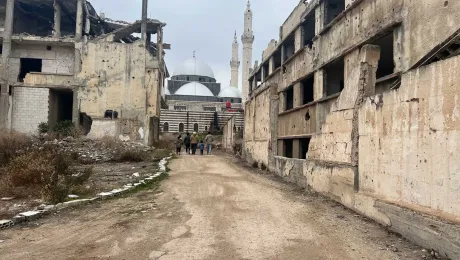
Caption: Bernadetta Myanura and her granddaughter Feza in the few square meters they have to themselves in the reception center. Photo: M. Renaux
Congolese refugees pour into Uganda
(LWI) – “I had five children. All of them were killed,” Bernadetta Myanura says. The elderly woman has a scar on her arm. Her granddaughter is all the family she has left. The 14-year-old-girl is standing beside her and looking at the floor. The clothes they are wearing are the only things they could save when they fled violence in the Democratic Republic of the Congo (DRC). That, and their lives. As they tell their story to a team of LWF visitors in late April, they are sheltered in a crowded reception center at Rwamwanja refugee camp, western Uganda.
The situation has worsened since then. For weeks, the number of refugees from the DRC has been increasing. According to UNHCR Uganda, thousands of people are pouring into Uganda each week from the eastern DRC, fleeing rape and abduction by Mai Mai militia, which claims to fight for the independence of the DRC’s Katanga province and is displacing thousands of families. In less than two weeks, 3000 Congolese refugees have arrived in Uganda. According to camp authorities, they tell stories which suggest a total breakdown of law and order in the eastern DRC.
New settlement for 15,000 refugees
The Lutheran World Federation (LWF) has received 1600 Congolese refugees at Mahane reception center and is expecting 1000 more this week. Most of the people are women and children. The LWF team in Rwamwanja camp supplies the new arrivals with relief items, such as blankets, pails and cooking pots, as well as pit latrine excavation kits. When the refugees are registered, the LWF staff also identify people with special needs, such as pregnant women and new mothers, people with disabilities, survivors of sexual and gender-based violence, unaccompanied minors and separated children. The LWF team also established a counseling desk at the reception center.
The Ugandan government has designated a new refugee settlement within Rwamwanja camp. The LWF is one of the main implementing partners at the new refugee settlement site called Mahiga. Covering 7.7km2, it is expected to accommodate 15,000 refugees. Each household will be allocated a 250m2 plot of land. The LWF, among others, will supply the refugees with shelter, agricultural support, protection and community services.
Nobody can tell how long they will have to stay. “People had started to go back to DRC, now they have to flee again,” a LWF staff member at the reception center says.


